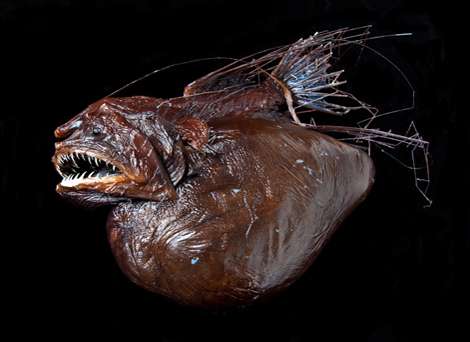3-D scans reveal deep-sea anglerfish's huge final meal (w/ Video)

Museum imaging experts discover that an anglerfish in the collections ate a fish twice its length, giving it an enormous expanded stomach.
A rare hairy anglerfish that entered the Museum collections 13 years ago has perplexed researchers with its massive stomach. Little is known about this deep-sea fish and what it eats, but the specimen was so rare scientists didn't want to cut it open to identify its last meal.
Now, using micro-CT scanning, a process that takes thousands of X-rays of a sample, researchers have created 3D model of the anglerfish's insides, revealing a fish twice its length folded up in its stomach.
A rare catch
The anglerfish was picked up on a research cruise near the Cape Verde Islands in the East Atlantic in 1999. Its capture was recorded in the cruise report:
'An unusually large Caulophryne pelagica [anglerfish] was captured in perfect condition, due perhaps to a lethargy induced by a prodigious meal which had expanded the stomach in excess of the standard length.'
On the cruise was a crew filming for the BBC documentary series Blue Planet, who took the opportunity to film the unusual fish when it was collected. It is now part of the Museum's spirit collections, preserved in a jar of alcohol.
Weird fish
This species of anglerfish lives at depths of around 2,500 metres, and is covered in antennae that give it the common name 'hairy anglerfish'. The Museum's specimen is the largest of only 17 examples discovered so far.
The bizarre specimen is a female. Males are far smaller and grab on to females with their teeth, becoming parasitic and feeding on their blood. Many of the male's organs then degenerate but the testes remain in full working order, ready for spawning.
The Museum's fish had no mate attached, but she did have a very large meal shortly before she was caught. Anglerfish are so called because they use a long fin ray with a fleshy growth at the end extending from their head to lure fish prey into their jaws.
They lie in wait for prey, and at depths where they live food is often scarce, which is why they swallow such huge prey in one go.
Getting inside
Museum fish expert James Maclaine said he could tell the anglerfish's meal was a large bony fish by feeling the stomach, but without looking inside he couldn't tell exactly what kind.
However, using the CT scanner to create a 3D X-ray of the skeleton inside the anglerfish's stomach, he was able to see some vital clues.
The backbone was visible along with a large eye socket and two hard bone-like objects called otoliths, which sit in the back of the skull and help fish figure out which way is up.
Otoliths are distinct to different species of fish, and with the 3D image, Maclaine was able to identify the unfortunate fish the angler had eaten once and for all.
You can scan inside the anglerfish yourself soon on the Museum's Inside Explorer Table. The table allows you to peel back layers of an Egyptian mummified cat, a meteorite from Mars and 20-million-year-old gecko trapped in amber.
The Inside Explorer Table is mobile, and can be found either in the Investigate centre or the Images of Nature gallery. Ask at the Information Desks near the main Museum entrances for the latest times and locations. A second table will be installed in the Darwin Centre in November.
Provided by Natural History Museum





















